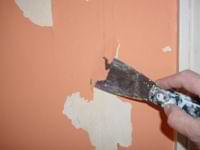Repainting Lead-Based Paint
by: Dale Cox

In April 2011 the EPA will finally put its long standing rules about lead paint abatement into effect. Back in 1991 new rules were established for dealing with painting and renovations on homes built before 1978. These rules were intended to stop lead poisoning in children due to disturbing household surfaces containing lead such as trim moldings, wall surfaces, and floor coverings. Old lead-based paint is of particular concern because of the very common practice of scraping or sanding in preparation for repainting. In addition to painting, activities such as demo work for remodeling walls and floors can disturb surfaces containing lead and release toxic dust into the home.
What the Rules State
Anyone being paid to do renovations or painting such as a home improvement contractor, is required to be trained and certified in methods of containing and cleaning up the lead dust involved in their activities.
EPA approved methods for dealing with renovations call for covering with plastic sheeting all surfaces where lead dust could settle in and around the work zone. Surfaces including floors, windowsills, countertops, and any other horizontal surface must be wrapped with plastic and sealed with tape. In addition, the plastic must extend beyond the work area by six feet in all directions. Also, a misting of water on surfaces is required while working to keep the dust from spreading through the air.
No demolition may be done that would spread debris such as breaking wall materials, etc. with a hammer. Instead, these surfaces must be gently broken apart in other ways. All power tools that cut, sand, or grind must be hooked up to a vacuum system with a HEPA filter to catch the dust and debris as it's produced. Also, heat guns used to strip old paint may not exceed 700 degrees Fahrenheit to keep lead fumes out of the air.
Workers performing duties that require disturbing lead-based paint and other surfaces must have proper personal protection such as respirators with HEPA filters. Also, protective clothing, gloves, head, and foot coverings are required. In addition, protective clothing must be removed before leaving the job site so lead is not transferred via workers' clothing to other locations.
In addition to using approved methods for containing any lead that may be released during renovation and painting, a contractor is also required to test the site after work is completed to ensure no lead residue remains on surfaces. All windowsills, countertops, floors, etc. must be swabbed and the samples sent to a lab for testing. Finally, a record of the job must be kept by contractors for 3 years to prove all work was done in accordance with EPA approved methods.
Exceptions to the Rules
There are a few exceptions to these stringent requirements. For instance, small jobs involving no more than six square feet in interiors and 20 square feet on exterior surfaces are exempt. Also, housing for the elderly and disabled is exempt if no child under 6-years-old is in residence or will be in residence there. Dwellings with no bedrooms such as an efficiency apartment are also exempt.
The DIY Loophole
If you are doing painting and renovations yourself on your own property, you are not bound by these new rules. This doesn't mean you should just disregard the possibility of lead dust being created by the work you are doing. Lead is toxic and exposure to it can cause serious illness, including brain damage, especially in children. If you have children, especially children under 6-years-old, you should be very careful they are not exposed to lead. Because a child's brain is still developing, lead is much more hazardous to them than to adults. Pregnant women should also avoid any lead in their environment for the same reasons.
Consumer paint has not contained lead in decades, however, anyone working in an older dwelling built before 1978 may encounter old, lead-based paint. While lead-based paint does not present a hazard when intact, i.e. no chipping, peeling, or chalking, if you are contemplating a typical renovation or remodeling project, know that you can disturb the painted surface and create lead dust.
Special attention should be given when you prepare any old painted surface for repainting. For instance, never use open burning methods to remove stubborn paint. If you scrape, sand, or remove old paint by any means, you may release lead dust or debris. Because of this inherent hazard, you should follow all the same procedural rules required of a hired contractor if you are working on lead-based paint in your home to protect yourself and those around you.
The EPA has published a pamphlet to help when considering renovations at this link. Use this link to find a certified contractor to do the work for you.